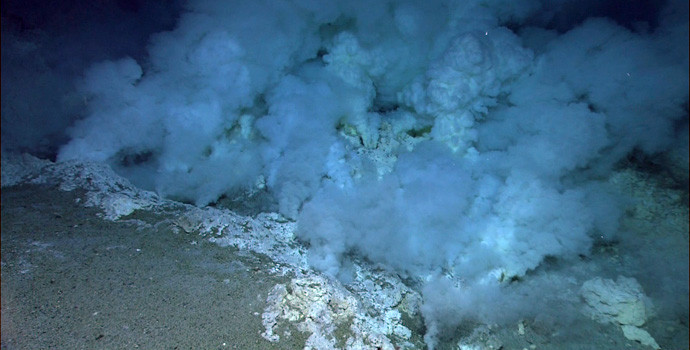Science:深海病毒遗传了细菌的能量基因

据一项新的研究披露,与海洋表面病毒在很久以前从蓝藻细菌那里遗传了光合基因类似,在深部、黑暗海洋中的热液喷口周围生活的病毒从繁茂生长的细菌那里获取了硫氧化基因。这一发现提示,噬菌体——或能感染细菌的病毒——在地球的硫循环中扮演着一种关键性的角色,且它们具有在黑暗的海洋中进行化学合成所需的遗传多样性。
Karthik Anantharaman及其同事对来自西太平洋及加利福尼亚湾的热液喷口羽状流中的18种噬菌体的基因组进行了测序,这些噬菌体专门感染一组叫做SUP05的海洋细菌。他们发现,他们的18个病毒基因组中有15个含有与逆向异化型亚硫酸盐还原酶或rdsr有关的代谢基因;rdsr是一种可氧化元素硫的细菌酶。
且因为硫是热液喷口附近的SUP05细菌的一个丰富的能量来源,研究人员提示,这样的病毒基因组可帮助补充或维持那些化学合成细菌的代谢。
原文摘要:
Sulfur Oxidation Genes in Diverse Deep-Sea Viruses
Karthik Anantharaman, Melissa B. Duhaime, John A. Breier, Kathleen Wendt, Brandy M. Toner, and Gregory J. Dick
Viruses are the most abundant biological entities in the oceans and a pervasive cause of mortality of microorganisms that drive biogeochemical cycles. Although the ecological and evolutionary impacts of viruses on marine phototrophs are well-recognized, little is known about their impact on ubiquitous marine lithotrophs. Here we report 18 genome sequences of double-stranded DNA viruses that putatively infect widespread sulfur-oxidizing bacteria. Fifteen of these viral genomes contain auxiliary metabolic genes for the alpha and gamma subunits of reverse dissimilatory sulfite reductase (rdsr). This enzyme oxidizes elemental sulfur, which is abundant in the hydrothermal plumes studied here. Our findings implicate viruses as a key agent in the sulfur cycle and as a reservoir of genetic diversity for bacterial enzymes that underpin chemosynthesis in the deep oceans.
作者:生物帮

